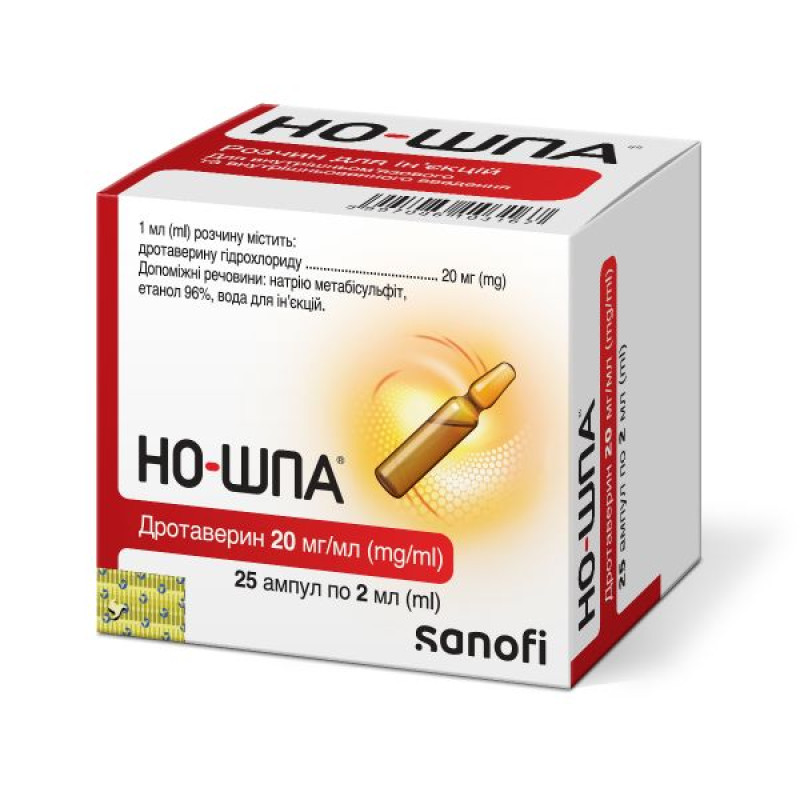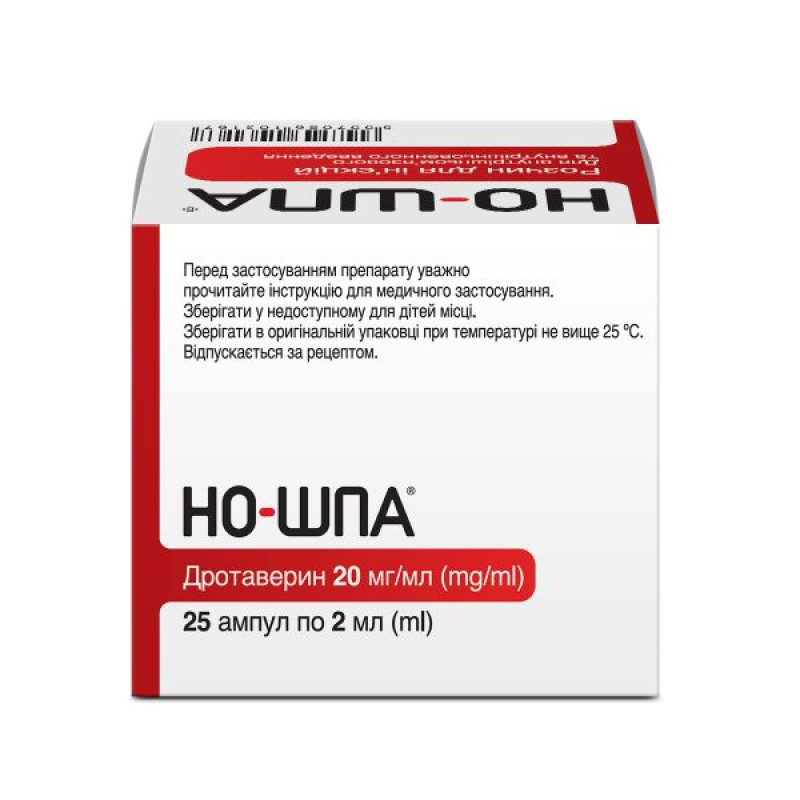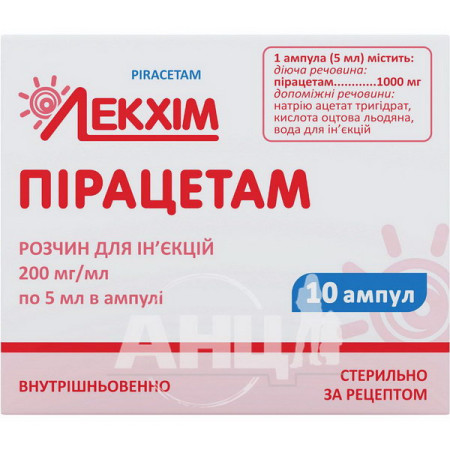No-shpa solution for injection 40 mg ampoule 2 ml No. 25

Instructions No-shpa solution for injection 40 mg ampoule 2 ml No. 25
Composition
active ingredient: drotaverine;
1 ml of solution contains drotaverine hydrochloride 20 mg;
Excipients: sodium metabisulfite, ethanol 96%, water for injections.
Dosage form
Solution for injection.
Main physicochemical properties: clear, yellowish-green liquid.
Pharmacotherapeutic group
Drugs used for functional gastrointestinal disorders. ATX code A03A D02.
Pharmacological properties
Pharmacodynamics.
Drotaverine is an isoquinoline derivative that has an antispasmodic effect on smooth muscle by inhibiting the action of the enzyme phosphodiesterase IV (PDE IV), which causes an increase in the concentration of cAMP and, due to the inactivation of myosin light chain kinase (MLCK), leads to relaxation of smooth muscle.
In vitro, drotaverine inhibits the action of the PDE IV enzyme and does not affect the action of the isoenzymes phosphodiesterase III (PDE III) and phosphodiesterase V (PDE V). PDE IV is of great functional importance for reducing the contractile activity of smooth muscles, therefore, selective inhibitors of this enzyme may be useful for the treatment of diseases accompanied by hypermotility, as well as various diseases in which gastrointestinal spasms occur.
In myocardial and vascular smooth muscle cells, cAMP is hydrolyzed mainly by the PDE III isoenzyme, therefore drotaverine is an effective antispasmodic that does not cause significant side effects on the cardiovascular system and does not have a strong therapeutic effect on this system.
Drotaverine is effective in spasms of smooth muscles of both nervous and muscular origin. Drotaverine acts on the smooth muscles of the gastrointestinal, biliary, genitourinary and vascular systems, regardless of the type of their autonomic innervation. It increases blood circulation in the tissues due to its ability to dilate blood vessels.
The effect of drotaverine is stronger than that of papaverine, absorption is faster and more complete, it binds less to serum proteins. Another advantage of drotaverine is that, unlike papaverine, after its parenteral administration, there is no side effect such as respiratory stimulation.
Pharmacokinetics.
Absorption. Drotaverine is rapidly absorbed both after oral administration and after parenteral administration.
Distribution: It is highly bound to plasma albumin (95-98%), alpha- and beta-globulins. Peak serum concentrations are reached within 45-60 minutes after oral administration.
Biotransformation. After primary metabolism, 65% of the administered dose enters the bloodstream unchanged. Metabolized in the liver.
Excretion. The half-life of biological existence is 8-10 hours. Within 72 hours, drotaverine is almost completely eliminated from the body, more than 50% is excreted in the urine and approximately 30% in the feces. Drotaverine is mainly excreted in the form of metabolites, it is not detected in unchanged form in the urine.
Indication
Smooth muscle spasms associated with biliary tract diseases: cholecystolithiasis, cholangiolithiasis, cholecystitis, pericholecystitis, cholangitis, papillitis.
Spasms of smooth muscles in diseases of the urinary tract: nephrolithiasis, urethrolithiasis, pyelitis, cystitis, bladder tenesmus.
As an adjunctive treatment (when the use of the drug in tablet form is not possible):
- for spasms of smooth muscles of the gastrointestinal tract: gastric and duodenal ulcers, gastritis, cardio- and/or pylorospasm, enteritis, colitis;
- for gynecological diseases: dysmenorrhea.
Contraindication
Hypersensitivity to the active substance or to any of the excipients (especially sodium metabisulfite). Hypersensitivity to sodium disulfite. Severe hepatic, renal or cardiac insufficiency (small cardiac output syndrome).
Special safety measures.
Due to the risk of collapse during intravenous administration of No-Spa, the patient should be in a supine position.
Use with caution in case of arterial hypotension.
The drug contains metabisulfite, which may cause allergic-type reactions, including symptoms of anaphylactic shock and bronchospasm in susceptible patients, especially those with a history of asthma or allergy. In case of hypersensitivity to sodium metabisulfite, parenteral administration of the drug should be avoided (see section "Contraindications").
Caution should be exercised when parenterally administering the drug to pregnant women (see section “Use during pregnancy or lactation”).
Children.
No clinical studies of the drug have been conducted in children.
Interaction with other medicinal products and other types of interactions
Phosphodiesterase inhibitors (No-shpa, papaverine) reduce the antiparkinsonian effect of levodopa. Caution should be exercised when No-shpa is used concomitantly with levodopa, as the antiparkinsonian effect of the latter is reduced and rigidity and tremor are increased.
Use during pregnancy or breastfeeding
Pregnancy. As shown by the results of retrospective clinical studies and animal studies, oral administration of the drug did not cause any signs of any direct or indirect effect on pregnancy, embryonic development, childbirth or postnatal development. However, this drug should be used with caution in pregnant women. Drotaverine should not be used during labor.
Breastfeeding. Due to the lack of preclinical data, administration of the drug during breastfeeding is not recommended.
Fertility.
There are no data on the effect on human fertility.
Ability to influence reaction speed when driving vehicles or other mechanisms
Patients should be warned that after parenteral, especially intravenous, administration of the drug, it is recommended to refrain from driving and performing work that requires increased attention.
Method of administration and doses
Dosage.
Adults.
The recommended daily dose is 40-240 mg (in 1-3 separate injections) intramuscularly.
For acute colic in adult patients with stones in the urinary or biliary tract – 40–80 mg intravenously.
Method of administration.
The drug is administered intramuscularly and intravenously.
Children
No clinical studies of the drug have been conducted in children.
Overdose
Symptoms: with a significant overdose of drotaverine, cardiac rhythm and conduction disturbances have been observed, including complete bundle branch block and cardiac arrest, which can be fatal.
In case of overdose, the patient should be under close medical supervision and receive symptomatic treatment, including induction of vomiting and/or gastric lavage.
Adverse reactions
Adverse reactions observed during clinical trials and possibly caused by drotaverine are distributed by organ system and frequency of occurrence: very common (> 1/10), common (> 1/100, < 1/10), uncommon (> 1/1,000, < 1/100), rare (> 1/10,000, < 1/1,000), very rare (< 1/10,000), frequency of occurrence is unknown (cannot be estimated from the available data).
From the immune system.
Rare: allergic reactions, including angioedema, urticaria, rash, itching, fever, chills, increased body temperature, weakness, especially in patients with hypersensitivity to metabisulfite.
Frequency unknown: There have been reports of cases of anaphylactic shock with fatal and non-fatal outcome when using the injectable form.
The drug contains metabisulfite, which may cause allergic-type reactions, including symptoms of anaphylactic shock and bronchospasm in sensitive patients, especially those with a history of asthma or allergies.
From the cardiovascular system.
Rare: palpitations, hypotension.
From the nervous system.
Rare: headache, dizziness, insomnia.
From the gastrointestinal tract.
Rare: nausea, constipation, vomiting.
General disorders and administration site conditions: local reactions at the injection site.
Expiration date
3 years.
Storage conditions
Keep out of reach of children.
Store in the original packaging at a temperature not exceeding 25 °C.
Packaging. No. 25 (5x5): 2 ml in an ampoule, 5 ampoules placed in a pallet, 5 pallets in a cardboard box.
Vacation category
According to the recipe.
Producer
QUINOIN Pharmaceutical and Chemical Products Factory Private Co. Ltd., Enterprise No. 3 (Enterprise in Chanikveld).
Location of the manufacturer and its business address
3510, Miskolc, Csanikoveld, Hungary.
Applicant
Opela Healthcare Ukraine LLC, Ukraine.
Location of the applicant and/or applicant's representative
Ukraine, 01033, Kyiv, Zhylyanska St., 48-50A.
There are no reviews for this product.
There are no reviews for this product, be the first to leave your review.
No questions about this product, be the first and ask your question.



















